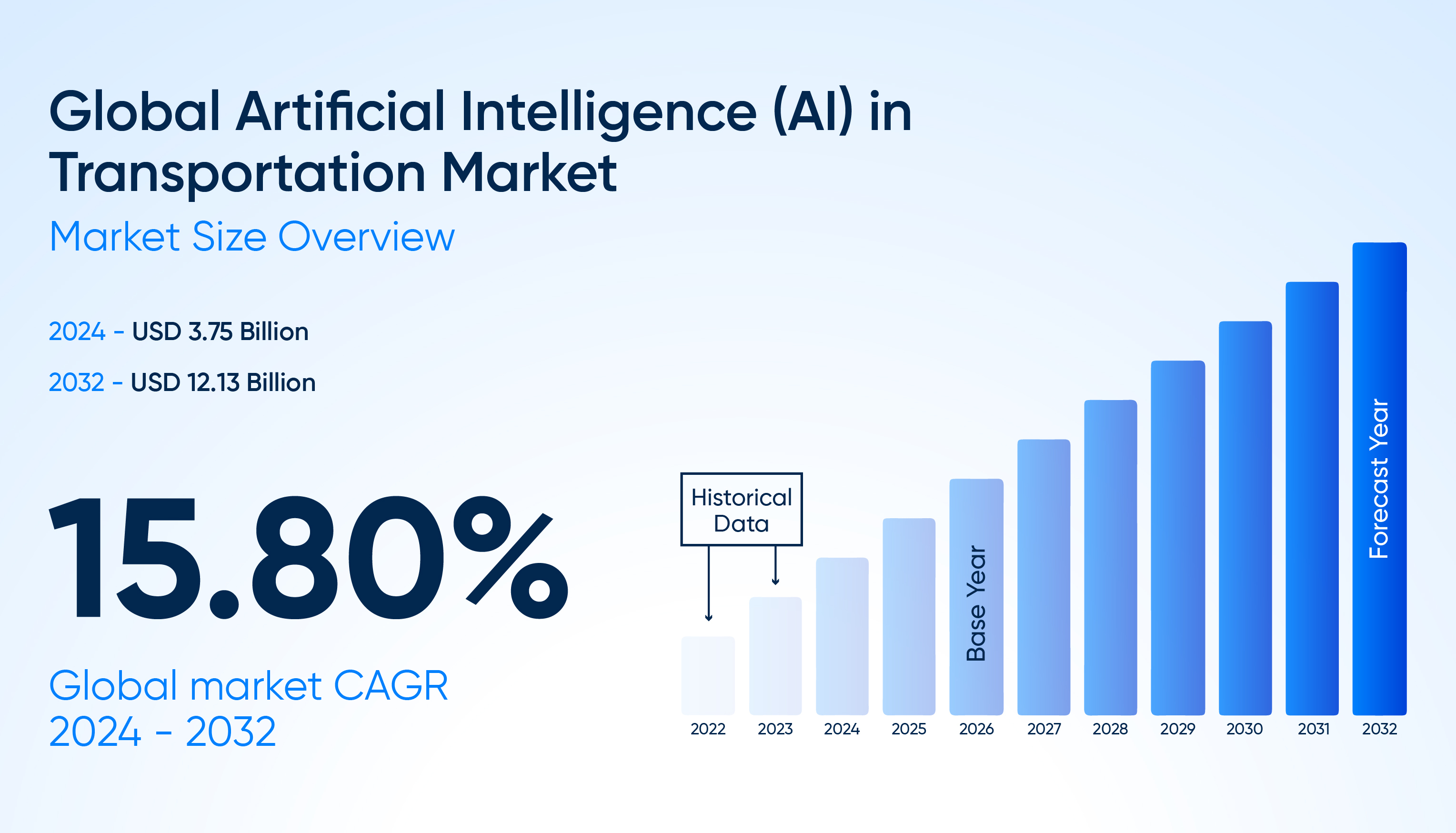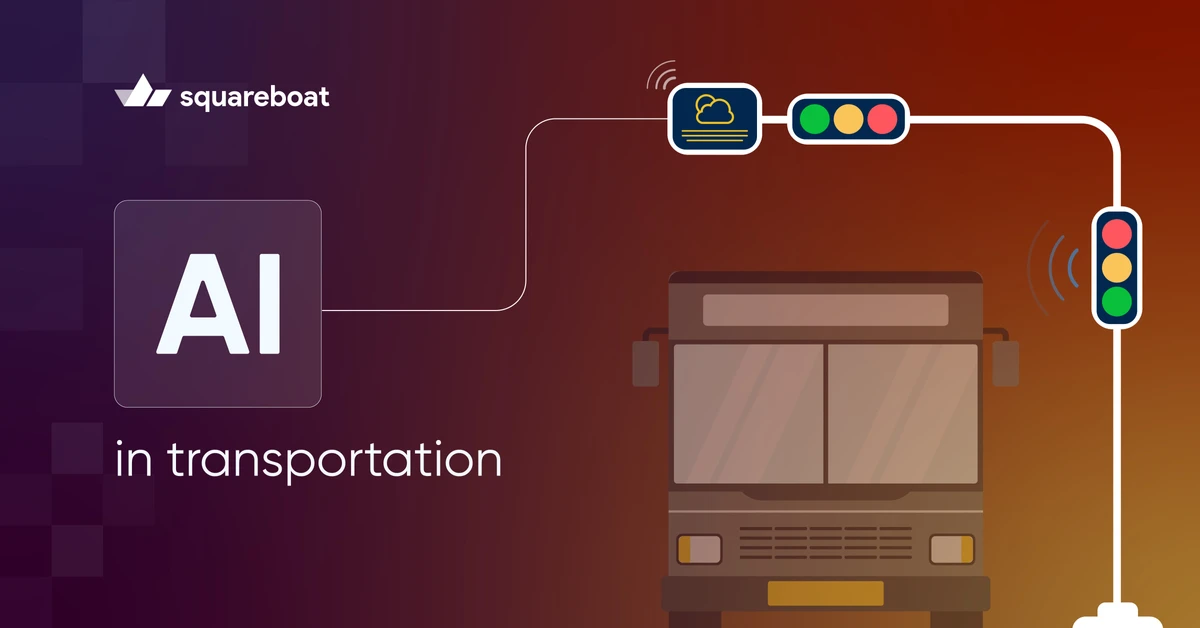AI in transportation is revolutionizing how we move people and goods. It's making travel more productive, safer, and easier worldwide. From self-driving cars to clever traffic control, AI breakthroughs are improving how we get around in ways we've never seen before. In this article, we'll look at how is AI used in transportation, its upsides, real-world uses, and what might come next.
AI in Transportation: Market Overview

The global transportation market is growing faster as more people want smarter, safer, and more productive ways to get around. According to a report by Market Data Forecast, the global market of AI for transportation was valued at $3.75 billion in 2024 and is projected to reach $12.13 billion by 2032, growing at a CAGR of 15.8% from 2024 to 2032. This growth is fueled by the adoption of AI-driven technologies, which include autonomous vehicles, smart traffic management systems, and AI-powered logistics platforms. Major automotive and logistics companies are investing heavily in AI to enhance efficiency, reduce operational costs, and improve road safety.
Benefits of AI for Transportation:
- Smarter Traffic Management: AI systems look at huge amounts of real-time traffic data to spot traffic jam patterns. This knowledge helps traffic control centers change signal times, which cuts down on bottlenecks and waiting. Cities that use AI to manage traffic say people spend up to 30% less time traveling.
- Predictive Maintenance for Vehicles: AI looks at data from sensors in vehicles to guess when mechanical problems might happen before they get bad. This way of fixing things before they break keeps fleets running well and stops unexpected breakdowns. It saves companies money on expensive repairs and keeps vehicles on the road longer.
- Optimized Route Planning: AI navigation tools use real-time data on traffic, weather, and road conditions. Delivery firms use AI to map out the best routes to cut fuel use by up to 20% and make sure packages arrive on time.
- Enhanced Fleet Efficiency: Fleet management systems use AI to keep an eye on how vehicles run, how drivers behave, and how to use them best. By looking at GPS and telematics data, AI suggests ways to use less fuel and make operations more effective.
- Improved Safety through Driver Monitoring: AI cameras and sensors spot when drivers are tired, not paying attention, or driving recklessly. These systems can tell drivers to take a break or fix their driving, which leads to fewer crashes and safer roads.
- Autonomous Driving Capabilities: AI plays a key role in self-driving cars. It helps them understand what's around them, make choices, and drive on roads. AI makes sure these cars keep a safe distance from others, spot people walking, and drive more safely and reliably.
- Smart Public Transport Systems: AI improves how buses and trains run. It can guess how many people will ride and change the service to match. This means better service when it's busy, less crowding, and happier riders.
Efficient Logistics and Supply Chain: AI makes supply chains work smoothly. It can predict what people will buy and keep track of where things are in real time. This clear view helps shipping companies store and move goods better, which cuts costs and gets things where they need to go more efficiently.
Top Use Cases for AI in Transportation:
Autonomous Vehicles
Self-driving cars and trucks are changing the game in transportation. These vehicles use AI to make sense of data from cameras, LiDAR, radar, and other sensors to decide how to drive in real time. AI helps with staying in lanes, adjusting speed to traffic, spotting obstacles, and keeping pedestrians safe.
Smart Traffic Management
Cities now use AI to control traffic lights and deal with congestion. AI looks at traffic data as it happens, figures out where jams might occur, and finds ways to keep traffic moving. This cuts down on travel time and gas use, while also making roads safer.
Fleet Management Optimization
Logistics companies use AI to manage big vehicle fleets. AI tracks vehicle status, plans the best routes, and forecasts repair needs. This cuts down on inactive time and boosts cost savings.
Predictive Maintenance
AI systems keep an eye on vehicle health as it happens, spotting odd patterns and foreseeing breakdowns before they strike. This hands-on upkeep plan reduces failures and makes transport assets last longer.
Passenger Experience Enhancement
Public transport networks apply AI to guess passenger numbers and handle timetables. AI-powered chatbots and digital helpers give up-to-the-minute info on when buses or trains will show up. This makes the journey better for users and helps transport systems run more smoothly.
AI in Logistics and Supply Chain
AI has a big impact on transportation in logistics. It helps optimize loads, forecast demand, and plan routes. AI-powered platforms can predict when shipments might be late and suggest other ways to get there.
Infrastructure Monitoring
AI-equipped drones and surveillance systems keep an eye on roads, bridges, and railways to check their condition. They spot damage, cracks, or possible risks, which allows for quick repairs and cuts down on accident risks. These AI systems play a crucial role in keeping transportation infrastructure safe and working well for years to come.
Real World Examples of AI in Transportation:
Tesla Autopilot
Tesla's AI-powered Autopilot system has set a new bar for semi-autonomous driving. It uses machine learning algorithms to process data from cameras, ultrasonic sensors, and radar. This allows functions like adaptive cruise control, lane centering, and automatic lane changes. Autopilot also helps with self-parking and summon features, which make driving safer and easier.
Uber AI for Dynamic Pricing
Uber applies AI to figure out dynamic fares based on demand, distance, and traffic conditions. Its AI algorithms forecast rider demand by looking at past data, events, and weather patterns. This lets Uber change prices in real-time, which ensures there are enough drivers available and cuts down wait times for passengers.
Waymo Autonomous Taxis
Waymo leads the self-driving industry and runs driverless taxis in multiple cities. These cars rely on AI to spot objects, guess how pedestrians will move, and drive through tricky city streets. The AI brain takes in data from LiDAR, cameras, and radar to make quick choices while driving, keeping riders safe and on the right path.
DHL Smart Trucks
DHL uses AI to find the best delivery routes and times. The AI looks at up-to-the-minute traffic, weather, and where packages need to go to plan the fastest routes. This cuts down on gas use, helps packages arrive on time, and saves money, making shipping smarter and better for the planet.
Smart Traffic Lights in Los Angeles
Los Angeles has put AI-powered traffic lights in place that change based on traffic levels. These lights use machine learning to guess traffic patterns and tweak their timing, which cuts down on jams and makes traffic flow better overall. This AI tool helps cars move through busy crossroads when roads are packed during rush hour.
Future of AI in Transportation Industry:
Fully Autonomous Fleets
In the coming years, logistics firms might start using self-driving fleets to move freight and goods. These fleets will use AI to navigate, spot obstacles, and make decisions, cutting down on human input and costs. Self-driving trucks will find the best routes and keep moving nonstop, making supply chains work better.
Smart City Integration
City travel will get much better thanks to AI-powered smart-city projects. Self-driving taxis and buses will become a big part of public transport, linked to smart traffic systems for smoother runs. AI will look at live data from many sources to predict traffic, cutting down on jams and travel time.
Predictive Traffic Systems
AI-powered predictive traffic management will let cities forecast traffic jams. These systems will look at past and current data, helping authorities to manage roads before problems occur. This will cut down on bottlenecks and make traffic move better, so people can get to work faster and on time more often.
Advanced Safety Mechanisms
AI will play a key part in cutting down crashes and making roads safer. Systems that watch drivers will spot tiredness, lack of focus, or sudden health problems. They'll warn the driver or take over when needed. AI-driven safety tech will also boost how cars talk to each other, stopping crashes before they happen.
AI-Driven Infrastructure
AI will play a key role in roads, intersections, and city layouts to work with self-driving cars. Smart roads packed with sensors will talk to AI cars, giving them up-to-the-minute info on road status, weather shifts, and possible dangers. This teamwork will boost the safety and smooth running of self-driving tech.
Key Challenges for Implementing AI in Transportation:
- Data Privacy and Security Concerns: Transport systems gather tons of data, like where you are, how fast you're going, and who's riding. It's crucial to keep this info safe from bad guys and hackers. If someone breaks in, they could steal identities, mess with vehicles, or grab sensitive business secrets. The challenge is to set up strong cyber defenses while still letting the right people access the data they need.
- Integration with Existing Infrastructure: Mixing AI with old-school transport systems is tricky. Many cities and companies still use outdated setups that don't play nice with new AI tech. To update these systems, you need a lot of time, smart people, and money. Plus, when you're doing the upgrades, it often causes a mess for a while.
- High Implementation Costs: Setting up and running AI systems can cost a lot for public transport and logistics. The expenses include creating software, adding hardware, getting data, and keeping everything working. Smaller companies or government departments might find these costs too much, which can slow down or stop them from using AI.
- Technical Limitations and Reliability Issues: AI programs might not work well in places that are hard to predict, like during bad weather or in busy cities. For example, self-driving cars might have trouble on roads without markings or where there's temporary construction. Making sure AI works well in all kinds of situations remains a big challenge.
- Ethical and Safety Concerns: AI-driven choices in transport can bring up moral issues. For example, how should a self-driving car decide what to do in a crash it can't avoid? To tackle these ethical problems, we need a full plan that balances human values with what tech can do.
- Regulatory and Legal Barriers: Governments around the world are still writing rules for AI in transport. It's key to follow safety rules, data protection laws, and responsibility guidelines. Keeping up with these changing rules can slow down the use of AI solutions.
Public Acceptance and Trust Issues: Even though AI-driven transportation could help a lot many people still doubt it. They worry about losing jobs and not being in control anymore. These concerns can slow down how people start using this technology. To make people trust AI more, companies need to be open about what they're doing and show that their systems are safe.
Conclusion
The role of AI in transportation is more than just futuristic speculation—it’s a transformative reality. AI-driven solutions are already making transport smarter, safer, and more efficient. From self-driving cars to intelligent traffic management, these innovations are reshaping the way we move and manage logistics. While challenges like data privacy and cost exist, the potential benefits far outweigh the hurdles. As AI technologies advance, the transportation industry will continue to evolve, offering unprecedented improvements in mobility and connectivity.
Additional Resources


